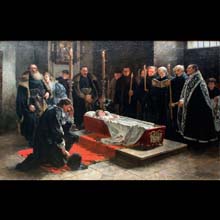
material: oil on canvas
dimensions: 136 x 216 cm
description: In the 19th century, while visiting a beautiful burial chapel housing the mausoleum of the Oświęcim family in Krosno, tourists could hear from local guides a legend about a great love between the siblings: Stanisław and Anna Oświęcim. The former, a courtier of King Władysław IV, received a papal dispensation to marry his sister. Unfortunately, when Anna, who was waiting for her brother to come home after a long journey, heard the good news, her heart could not bear it and she died. Her devastated brother built a burial chapel for her and died soon afterwards. Although Karol Szajnocha cast doubt on the authenticity of the legend, it lived its own life. It proved a great subject for a large picture. The motif was employed by Stanisław Bergman, a painter who undertook studies in the composition class run by Jan Matejko in 1887. The artist did not illustrate the whole story, but depicted the most moving moment, arousing sympathy in the viewers and their participation in the scene: the grief felt by the brother over the coffin of his beloved sister who is portrayed with other people taking part in the funeral: his father and young stepmother, other members of the family as well as representatives of the Polish gentry and clergy, including Franciscan brothers. The legend and its illustration define the painting as a historical anecdote, a popular genre in 19th-century history painting. Barbara Ciciora
exposition: The Gallery of 19th Century Polish Art in Sukiennice,
The Cloth Hall, 1, Main Market Square
key: Around the academy >>>
dimensions: 136 x 216 cm
description: In the 19th century, while visiting a beautiful burial chapel housing the mausoleum of the Oświęcim family in Krosno, tourists could hear from local guides a legend about a great love between the siblings: Stanisław and Anna Oświęcim. The former, a courtier of King Władysław IV, received a papal dispensation to marry his sister. Unfortunately, when Anna, who was waiting for her brother to come home after a long journey, heard the good news, her heart could not bear it and she died. Her devastated brother built a burial chapel for her and died soon afterwards. Although Karol Szajnocha cast doubt on the authenticity of the legend, it lived its own life. It proved a great subject for a large picture. The motif was employed by Stanisław Bergman, a painter who undertook studies in the composition class run by Jan Matejko in 1887. The artist did not illustrate the whole story, but depicted the most moving moment, arousing sympathy in the viewers and their participation in the scene: the grief felt by the brother over the coffin of his beloved sister who is portrayed with other people taking part in the funeral: his father and young stepmother, other members of the family as well as representatives of the Polish gentry and clergy, including Franciscan brothers. The legend and its illustration define the painting as a historical anecdote, a popular genre in 19th-century history painting. Barbara Ciciora
exposition: The Gallery of 19th Century Polish Art in Sukiennice,
The Cloth Hall, 1, Main Market Square
key: Around the academy >>>












